You are currently browsing the variant covers category
So as I may have mentioned once or twice in the past on this here weblog thingie that I enjoy Watchmen ephemera and other inappropriate tie-ins. Not that I think they’re important additions to the Watchmen story, but rather I enjoy observing how people who aren’t Alan Moore or Dave Gibbons and their Watchmen creative pals handle characters and situations that were never really intended for usage outside their original context. Sometimes it’s an ill-advised crossover comic, sometimes it’s a big ol’ box of Heroclix game figurines, sometimes it’s a poster featuring even more merchandise. But whatever it is, I’m invariably interested in it.
Similarly, I have an interest in Marvelman/Miracleman and whatever weird tie-ins exist beyond the original comics themselves. There’s not nearly as much as there is for Watchmen (I mean, there’s the button, and this wacky series) which makes things a little easier on me trying to track down all this nonsense.
One that nearly got past me was Marvel’s one-shot Timeless, which hints at a coming meeting between the Marvel Universe and Miracle/Marvelman. By the time I found out about it, all my copies were sold out, which actually worked out since they eventually released a reprint with a nice Miracleman cover by its current-if-decades-interrupted artist Mark Buckingham.
Which leads me to why I called you all here today. In honor of the 40th anniversary of the initial Moore/Garry Leach revival of the character, pairing ol’ MM with a variety of superheroes on variant covers of their titles. I know, I know, I’ve said in the past that I hate these misleading cover images featuring (sometimes) the stars of the book with other folks who don’t appear inside. But I am weak, and have decided that I need one of each of these. “But Mike,” you ask, “why not just download the images from Marvel or wherever instead of taking home even more comics,” and my reasoned response to you is “SHUT UP, JUST SHUT UP.”
Anyway, here are a few of those images…I’m quite taken the X-Force one:
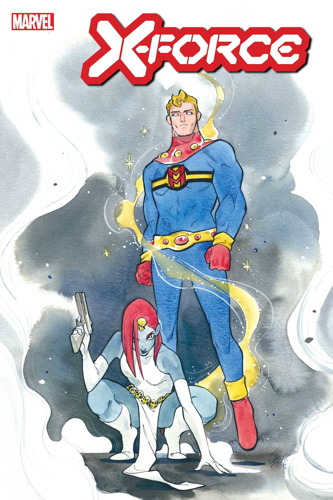
And this Captain America one is nice and cheery:
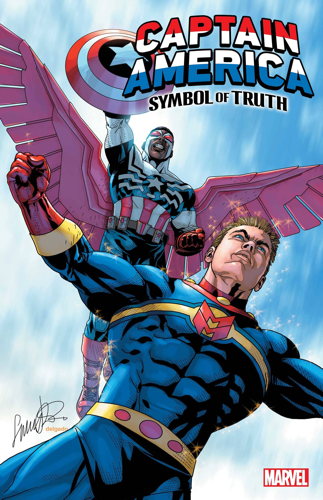
This one is quite busy:
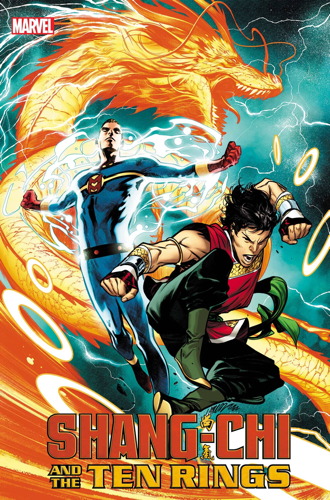
And…I don’t know, your guess is as good as mine:
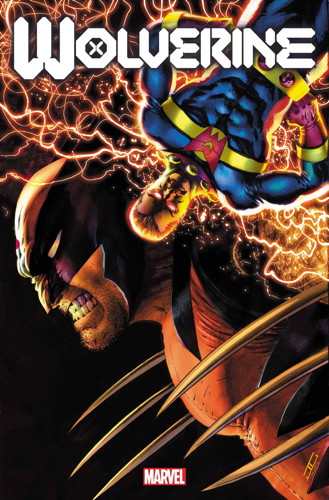
These are just a few of the many MM variants that are heading our way, and at least a couple make me wish we’re getting actual team-up stories inside (“Miracleman and Sam Wilson go out for a nice flight around the city.” “Wolverine finds himself with a tiny Miracleman lodged in the side of his head.”) but I guess that’ll have to wait ’til we get whatever was teased with that Timeless comic.
While finding these images, I did spot an old solicitation for the Miracleman: The Silver Age #3 from early 2016, which was going to feature at long last the new Neil Gaiman/Buckingham chapters of the story they’d started way back when at Eclipse Comics. Well, apparently at the end of the year we’re finally getting those long-promised stories, no, honest, we mean it this time. Back in 2016, one of the covers promised for that #3 was a “Hip Hop variant,” which alas had no art available with the solicit, but there was this Skottie Young cover that I hope gets offered again:
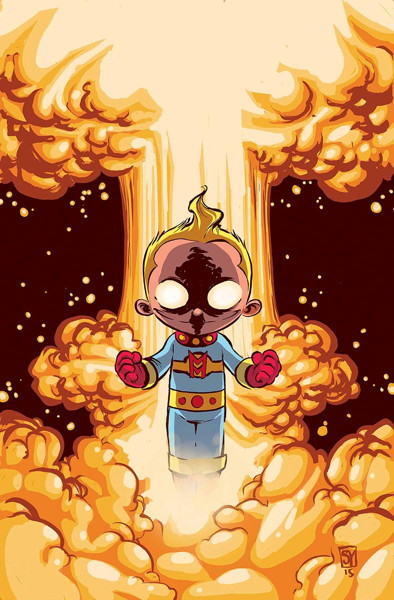
Once Gaiman/Buckingam finish their run, give Young the book. Or if the Miracleman story has come to its conclusion, have Young redraw the entire series. I’d read it, though the redone childbirth issue would be something else.
So for whatever reason I was chatting with pal Matt at the shop about John Byrne, wondering what his last published job in comics was (it was Matt who noted those weird Star Trek fumetti books may have been it). Anyway, this necessitated bringing up the ol’ Wikipedia entry on Byrne (which he would have wholeheartedly disapproved of me doing) which included the following tidbit:
“Byrne also facilitated the 1986 relaunch of DC Comics’ Superman franchise, the first issue of which featured comics’ first variant cover.”
Well well well, the eleven people out there who still read this site, and especially are reading the variant cover-age posts, know this isn’t necessarily the case. And I’m not even talking about the whole Whitman thing, or the Lone Ranger recoloring which may or may not exist. Or any of the other minor differences that were more publishing/distribution things than deliberate marketing gimmicks (like changing cover prices, or distributor marks, across print runs).
I’m talking about straight-up simultaneously publishing different covers on the same comic book to either 1) make the consumer choose which cover s/he wanted, or 2) tempt the consumer into buy each version. Byrne’s Man of Steel #1 (discussed here) is certainly the comic that introduced the idea to comic publishers “hold on, we can do that?” But I still contend MAD Magazine #123 from 1968 (with its four different covers) is the first “variant cover” comic book in the sense we mean it today: a single issue specifically published and marketed with alternate covers.
I did argue in that post that the publisher likely didn’t expect anyone to really buy multiple copies, though almost certainly somebody did. The express purpose of the varying serial numbers was to get a laugh from anyone perusing copies on the stands, before even (hopefully) buying the mag. Or from friends comparing copies, maybe. But still, those are variant covers, and a cover blurb does command you to “COLLECT THEM ALL” (technically a joke based on the idea of buying millions of these), so, you know, close enough for horseshoes.
The out, I suppose, is whether or not you consider MAD Magazine a “comic book.” And there are plenty of other workarounds/explanations/excuses, I’m sure…”oh it doesn’t count because that was just a joke, and Man of Steel is SERIOUS BIZ-NESS,” like that. But I guess calling Man of Steel #1 “the first standard-sized comic book to be purposefully published and marketed with more than one cover in order to get you rubes to buy multiple copies” is bit of a mouthful, despite being more accurate a description.
Man, I haven’t yet even touched on some of those Dell Comics from the 1950s/60s that had variant back covers on some of their releases. Again, more to do with distribution/other vagaries of publishing than anything else, but still, them’s is variants!
Okay, I know this post is mostly rehashing older posts in the variant cover-age series. Sorry about that. New content in this line of postings will happen again shortly. Thanks for reading, pals, and I’ll see you Wednesday.
Okay, let me catch up on a few more questions from some posts earlier this…er, last month:
Mike Loughlin wants me to cover
“Is there any demand for older, limited variants? For example, do people come in looking for the 1:100 Superman Unchained cover anymore, or does the interest dry up once the book has been released? What about for less popular books (say, a 1:100 variant for an Outsiders series from about 5 years ago)? Do you sell those variants at a discount if they don’t move after a few weeks?”
Usually once the sales window on a new comic closes (generally about a month, when the next issue comes in), if any of the pricier “ratio” variants haven’t moved by then, that’s likely it. I’ll put them in a box on the counter marked “VARIANTS,” and occasionally they’ll sell out of there, but honestly I really should mark them down or something.
But yeah, with rare exceptions the demand drops on these variants almost immediately, regardless of how big or small, how hot or lukewarm, the comic may be. I can see some of them going for, and actually selling, for big money, but every time I try to sell a pricier variant online I get bupkis, so I stopped trying. Though maybe I should throw a few for cheap up on my Hipcomic page. I’ve been having better luck selling comics there than I ever did on eBay.
• • •
Joe Gualtieri speculates
“Wouldn’t some artists with established fanbases like Hughes or Campbell be worth it to get the variant every time out, or close to it?”
Well, sure, if you like those artists. And sometimes they can hold value…but not always. And usually it’s not the one you’ll think it’ll be (though with “investment” apps and a pretty wide echo chamber repeating to all who will listen “this will be hot” we get a lot of self-fulfilling prophecies).
• • •
Matthew Murray
crowns me with
“Did you notice any increase in interest among your customers for the King Spawn series after selling those #1s for 99 cents each? Did m/any customers add the title to their pull lists? Did you order more of #2 than you would have otherwise?”
I did bump up orders on #2, and sold through, but as time went on the King Spawn orders normalized to about what I’d normally order on Spawn comics. And by “about” I mean I’m selling a little bit more on all the Spawn comics, though sales on those books had been creeping up a tad of late anyway.
Will get to the rest of questions later. But first, I must enter the Odinsleep. See you folks on Monday, and as always, thanks for reading.
I sorta skipped over the comments to my Amazing Spider-Man #194 variant post, but there’s a lot there and I’m not sure where to start addressing what you folks said. So let me start with Chris V talking about this:
“I guess the biggest question is if it’s worth it to the comic store to order X amount of a certain comic book just so they can get the rare variant edition. I think the value of the rare variant is enough to cover the cost to the retailer.
“There is some trepidation that stores over-ordering in order to get a copy of the rare variant edition could be creating a bubble, but I think a majority of the comic stores that remain are run by people who understand the business.”
It really does depend on the variant in question. And if, of course, said variant is going to see in demand. You never know if the fickle tastes of the speculator market will deem it “worthy,” or even if someone will come along who just likes the cover for what it is to buy it. Seems like it was easier in The Old Days (i.e. the ’90s) to move all variants all the time, what with the higher traffic more stores saw, and more people being willing to pay a premium to take home a variant.
Today, with higher prices on your regular comics, and just great reticence against spending more money on your weekly funnybooks than deemed necessary, it feels like variants are in general a harder sell. Not if, like I said, the speculators and the YouTube channels and the apps and whatnot decide a certain variant Is It, in which case you’ll never have ordered enough. But aside from those unpredictable cases, a variant is just as likely to sit there as not.
The theory is that you’d price up a variant cover to make up for the cost of the extra issues you’d have to order in order to get that variant. Well, more or less like that, there’s no exact formula. But a lot of times nowadays, if I get a 1 in 10 variant, I may just put it out there at cover price. Ratios higher than that do get the higher price tags, but not as high as I would have thrown on them, say, 10 years ago.
Back when Superman Unchained #1 was released, it came with a boatload of variants, and we did have a large number of customers interested in those. As I recall, there were ratio variants going up to 1 in 100 and 1 in 300. Well, I did the math, decided what I’d make on the variants, especially the 1/100 and 1/300 variants, I’d make money if I went in on 300 copies. Given the number of Superman readers we had at the shop, even for a book drawn by Jim Lee, that was a lot for us. Maybe not a drop in the bucket for some of your larger stores in big cities, but for a shop in Ventura, CA, that was more than plenty.
So I ordered those numbers, and once the books we sold those Big Variants right away, then sold nearly all the rest of the more attainable variants, and plenty of the standard comics as well, so we definitely pulled a profit out of this. Definitely more money that we would have made had we just ordered a lower number of the regular issue and eschewed those higher-ratio covers. The only real downside is being stuck with a bunch of extra Superman Unchained #1s in stock. They were all basically paid for, and while I had some long-term plans for them (such as using them as Free Comic Book Day giveaways) I did leave that shop to open my own store the next year, so I never was able to enact any cunning strategies.
Years later, I did a thing with King Spawn #1 at my own shop that, in retrospect, I should have done with that Superman Unchained. I had to order a large number of that King Spawn #1 in order to get the limited variant signed by Todd McFarlane. In this case, I had a customer prepay for the signed comic, and he paid enough to where when the comics arrived, I was able to put out all the regular not-ratio #1s for ninety-nine cents.
Had I kept them at cover price, I might have made more money per piece, but I wouldn’t have moved as many pieces. But the comics had all basically been paid for, so anything I made on them would have been gravy. And by charging under a buck apiece, they’ll eventually all go away and I won’t be stuck with unsold stock. (In fact, I’m on the very last few copies of those #1s right now.)
Another case where I order more copies than I can actually use is BRZRKR, but that’s only because I have a customer who wants all variants to the title. I charge enough for those variants to make up for the extra copies I don’t sell (though not enough to also sell the BRZRKRs for a buck each…there can be an upper limit to what folks are willing to pay) so I’m not losing money. Now I could possibly have a higher margin of profit if I didn’t order all those extra copies, but I’m still making money and I’m making a good customer happy, so that works for me.
But beyond those exceptions…I take it easy on the variants. I don’t buy extra copies of the regular covers to get more the rarities, because if nobody cares, then you’re stuck. It’s easy enough to get stuck with stock even without adding fuel to the fire like this.
I keep thinking about doing one of those “custom retailer covers” for some book or ‘nother, but the buy-in (and number of copies involved) is so high that I haven’t convinced myself to bite the bullet. Again, there’s always the issue of “what if nobody wants that particular variant,” leaving you with unsold stock, though I’m sure there are plenty of people out there who buy things because they’re scarce. But you never know, and it can be a big chance to take, especially for a little ol’ comical book store like me.
I have more to say on comments to that post, but that’ll have to wait for another day. And as a reminder, I may be in low content mode for at least part of next week as I attend more early morning doctor visits. I’m fine, I’m pretty sure, just the appointments all bunched up at around the same time. Thanks for reading, and we’ll talk again soon.
So the other day, customer Ryan asked me if I’d heard about a particular error (or dare we say, variant?) cover that’s been making the rounds lately. “I have not,” sez I, and he goes on to inform me about this issue of Amazing Spider-Man, #194 from 1979:
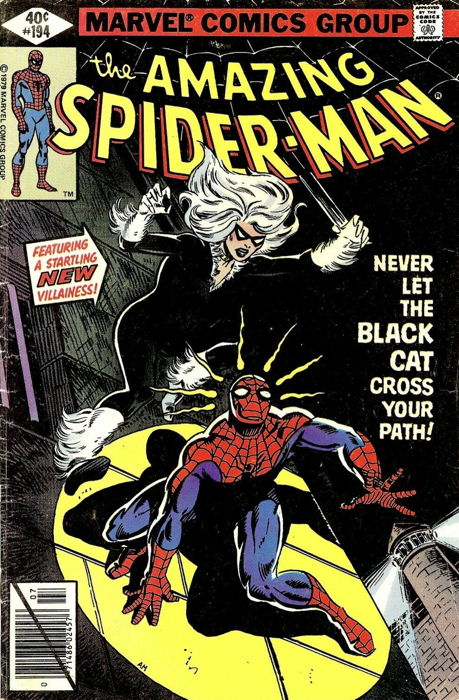
Well, okay, not this version specifically (which is a direct-sales edition, as noted by the slash through the UPC code, as opposed to a newsstand edition), but rather this one:
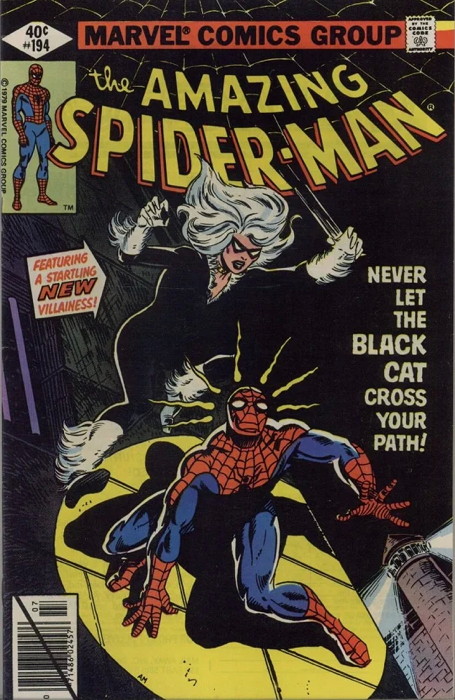
See the difference? Take a closer look:
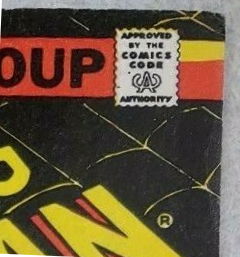
Apparently there was a problem in the printing process somewhere along the line leaving that miscolored strip on the Marvel Comics banner. At some point early in the process the problem was noticed and fixed (reminding me a little of this), making the majority of the books printed with the solid red bar, but the handful with the error were kept and passed along into distribution, since, you know, it’s such a minor thing. Doesn’t affect the readability of the book at all, who’s gonna care?
Well, cut to the 2020s, where there is a whole new market out there of folks looking for just about any reason to make any comic into a desired collectible. Given the huge emphasis of late on speculation in regards to first appearances of characters (whether or not that character has any real impact, (cough Gold Lantern cough*), one would think it’s enough that this specific issue is the first appearance of longtime Spider-Man frenemy the Black Cat, already skyrocketing in price as-is with eBay auctions titles including things like “Marvel comic KEY” and “Black Cat MCU Sony.”
However, this “error” variant is demanding a little extra chunk of change on the secondary market (“RARE YELLOW ERROR PRINT! MCU SOON!”)…to the tune of about a couple of hundred extra bucks at the high end, if the Hot Comic App is to be believed.
I can’t say if I’d ever come across one of those over the decades. It’s possible I haven’t, if the item is as rare as being ballyhooed. But even if I had, I doubt any of us at the shop would have paid it any mind…or possibly, in those early days of youthful optimism and/or ignorance, even marked the price down in the hopes of countering any initial buyer reluctance toward buying a book with such a sorely-visible misprint. Well, time and the current marketplace has surely corrected that oversight.
Anyway, thought this was an interestingly extreme example of the lengths the back issue market has gone through to make a fancier silk purse out of a plain ol’ silk purse. Mark my words, when the Ka-Zar movie happens, all those copies of Ka-Zar comic with the missing panel I’ve been stockpiling will make me rich, rich I tell you.
* Yes, I know he’s involved in that JLA/Legion of Super-Heroes thing.
Okay, I had planned to jump back into Variant Cover-age Mondays here on the site again, but as I was working on the planned subjects for said post, I realized I didn’t have the info I needed to properly put them in their retailing/collecting context. So, let’s have that one sit in the oven a little longer.
Instead, I’m going to go on a variant tangent, as well as touching another popular topic on this here website, and take notice of this forthcoming variant for the Marvel Comics one-shot Timeless:
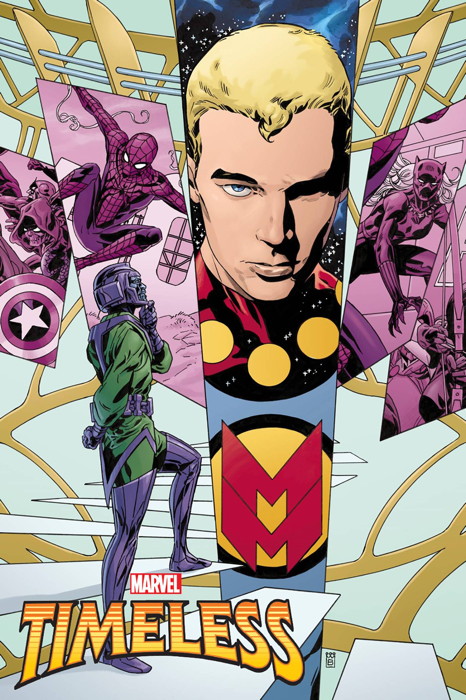
Due out in a couple of months, it plays up the fact that (spoiler, I guess) a character has visions of the Miracleman (or is it?) logo, revealed at the end of the story. I found out about that particular twist just in time for me to have sold out of my last copy…I did get a restock of some of the variants, but none of those did anything for me. And the forthcoming 2nd printing features that awful Punisher redesign, so a hard pass on that.
But that third printing? With ol’ MM front and center? Drawn by Mark Buckingham, the fella who illustrated Neil Gaiman’s truncated run on the character? Yes sir, that’s for me.
Now Miracleman at Marvel has not had an easy time of it. First, Alan Moore asked that his writing credit be removed (replaced by “The Original Writer”). Then the comics themselves were bloated, expensive messes, featuring the comics people actually wanted to read, backed up with extra editorial pages and reprints of “pre-return” Marvelman stories that nobody really wanted. And then of course there were the printing screw-ups, which, by the way, Marvel never did reissue corrected copies of that comic. Plus there’s the fact that the promise of new stories picking up from where the original series left off (with Eclipse Comics going out of business) was never fulfilled.
Well, Marvel put a lot of cash and time into straightening out all the rights issues and getting the character under their umbrella, so I guess they need to get their money’s worth. Now whether this is a new version of Marvelman (separate from the Miracleman comics by Moore and Gaiman), still called Miracleman but again separate from Moore/Gaiman, or (the most hilarious option) the next chapter of that Moore/Gaiman story, with MM dipping into the Marvel U. between installments of his own book.
I have no idea what will be the case, of course, and one wonders what kind of a fit MM would have in the Marvel Universe, even if only temporarily (see also: DC Universe and Watchmen). But we’re either getting an ongoing series with the character out of this, or (crossing fingers) those new stories from Gaiman and Buckingham picking up from where they left off decades ago will finally see the light of day.
Anyway, writing about this reminded me of the limited-run non-3D editions of Miracleman 3-D Eclipse offered way back in Ye Olden Tymes. This article seems to have that pretty well covered.
So I recently found out that the Roku Channel, which is a free streaming service available on, of all things, the Roku streaming device, features a series called Slugfest. It’s a number of short episodes devoted to the back-and-forth between DC and Marvel Comics over the last eight decades or so. (Yes, I know it wasn’t technically “Marvel Comics” early on, nor was DC technically “DC,” but you know what I mean.) Each episode is only a few minutes long, with a mix of vintage video/images and actor reenactments. (Most interesting is Brandon Routh playing a young Jack Kirby…I mean, he’s got the eyebrows, but he’s gotta be at least a foot taller than Kirby ever was; and Ray Wise as older Jack Kirby is about as perfect a casting as you can imagine.)
I bring it up because Episode 8 of the series, “World Without a Superman,” brings us back to our old friend, Superman #75:
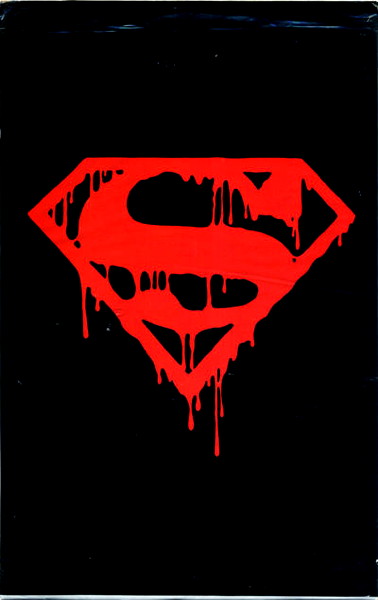
Yes, longtime readers of this site have heard me go on and on about this particular event, from my experiencing the madness from behind the counter at the comic shop I worked at back then, to the aftermarket life the book enjoyed (for varying values of “enjoyed”) in the decades since. Well, if you’re new around here, this here link will catch you up on all those ramblings.
And of course I have touched upon the Death of Superman madness in this very series of Variant Cover-age posts, mostly just talking about the “platinum editions.” But it occurs to me, I haven’t really talked much about the more common black-bagged version in this context. Not that I haven’t spoken about it at length in the past, but I feel like it should at least be brought up, especially in reference to that Slugfest episode.
To give you a little context, the Superman family of books (Action, Superman, Adventures of Superman, and Superman: The Man of Steel) were selling relatively well, at least for us, at the time. They effectively functioned as a weekly Superman comic, with each issue of each series coming out on separate weeks, storylines and subplots flowing from one to the other. It was very effective serialized storytelling. Also, keep in mind we were still riding the wave of the comics book of the late 1980s/early 1990s, so lots of comics were selling very well.
When it came time to order Superman #75, the actual Death of Superman issue, we ordered high. We’d already bumped up numbers on the preceding issues featuring the story leading up to the Big One, but on #75 itself, we ordered something like ten times what we’d normally order on the Superman comic. We were, we thought, taking something of a chance on this event book. It would do well, surely, but well enough to sell us out of 10x normal Superman orders? We’ll see.
Oh, and by the way, when I’m saying “we ordered” and “we thought,” I mean “Ralph ordered,” as my former boss was placing all the numbers, and I was but a lowly employee.
Anyway, as you all know, it came out, lines around the block, stores could’ve sold lots more than they ordered, et cetera et cetera so on and so forth. And the variant sealed in the black bag with all the goodies, the one we ordered the heaviest numbers, was the one in primary demand. Not to say the “standard” edition:
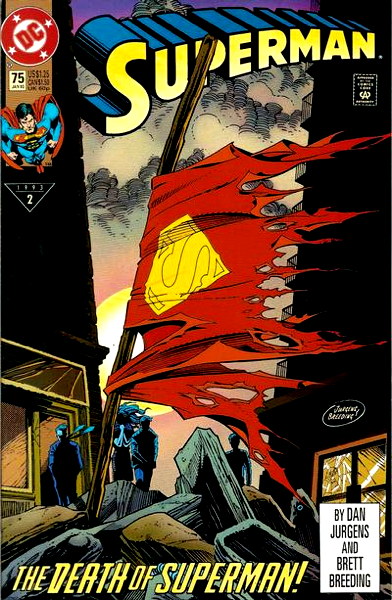
…didn’t also sell, because it sure did. And when the reprints hit, we sold lots of those, too. Needless to say, there were tons of copies of this sold. About 3 million copies altogether, according to the Slugfest episode.
And yes, here we come to the reason for this post. There’s a scene, a reenactment with actors portraying Superman writer Louise Simonson and a friend of hers, just hanging out at home. It had been noted that the Superman creative team were under a Non-Disclosure Agreement regarding the eventual resolution of the Death of Superman storyline (spoiler: he comes back). The scene, going entirely from my memory, was something like this:
FRIEND: “My son is buying lots of copies of this comic. When he gets more money, he’s going to buy more. These are going to put him through college someday.”
LOUISE SIMONSON: [coughs]
And the narrator (Kevin Smith, naturally) makes sure to tell us “the comic only goes for about five bucks now.”
Mmmmm…I beg to differ.
A while back I wrote about the fact that most people who bought the Death of Superman books were not comic collectors, were mostly folks from outside the hobby who picked up an issue out of curiosity or “investment,” who had literally no idea how to properly store or care for a comic book. The vast majority of comic collections I see from around this period, even from folks who bought the bags and boards and Mylar™ and such, are not in Near Mint, or even Fine or better, condition.
In the nearly 30 years since Superman #75 came out, I’d imagine most copies held by non-collectors were not stored well, or even just straight-up discarded once their passing interest in the comic faded. Plus, I suspect attempts to sell the book later to recoup on their investment resulted in some disappointing offers. “Wait, it’s not worth thousands?” It’s probably even worse for the folks who bought copies from opportunistic scalpers, selling them for a hundred dollars a pop the weekend after release (as I heard about locally, and probably wasn’t uncommon elsewhere).
End result: probably not as many minty-mint copies of any version of Superman #75 out there as you may think. It’s not uncommon, but it’s less likely now that you’ll walk into a store with a ready stack of them for sale.
I only ever see one or two at a time of the black-bagged version, and almost never see copies of the standard #75, or even its many reprints. And while I’ll buy the mint copies (or at least cleanly-opened copies with the extras perserved) from collections, I have seen plenty of copies that are just trashed and that I’ve passed on purchasing. As such, it is my belief that a nice copy can still fetch a premium price…and actually does, as I’ve sold more than a few in my shop. And by “premium” I definitely mean more than five bucks.
A quick look at the eBays shows copies of the black-bagged edition selling for, on average, between $10 and $30. Yes, to be fair, I did see a sealed copy sell for $5, but that seemed like an outlier. A couple of the standard editions did sell for about $6 to $8, so that’s a little closer to the show’s assertion. A check of currently-offered copies at Hipcomic don’t show much variation, though they do seem to have a lot more of the reprints than eBay did. (I’m not bringing up “professionally graded” sales, as that’s its own super-distorted marketplace.)
I also did a quick search of a couple of the larger online stores and didn’t even spot any (except for one store that had it for over $150, which is probably why they still have it). Hardly a scientifically thorough search, and for all I know they just had it and sold it before I looked.
The end result is…no, Superman #75, in either its black-bagged or standard edition, isn’t going to pay for anyone’s college. Even the platinum edition might only net you enough to pay for a couple of textbooks. But, I think the “five bucks” descriptor was bit of an underestimation. There’s still a market for these, just that the market value has normalized to meet actual demand, long after that initial rush and immediate scarcity drove some panic buying.
Now that white covered Adventures of Superman #500…if I got five bucks a pop on those, I’d be ecstatic.
Let me know if you’d seen any of those Superman #75s out for sale in your area. Are they going for premium pricing? Are stores stuck with a bunch and trying to unload them? (I’d rather you didn’t mention store names, in case they take offense to being held up as an example of “charging too much” or something.) I’d be interested to hear what’s going on with these across the marketplace now.
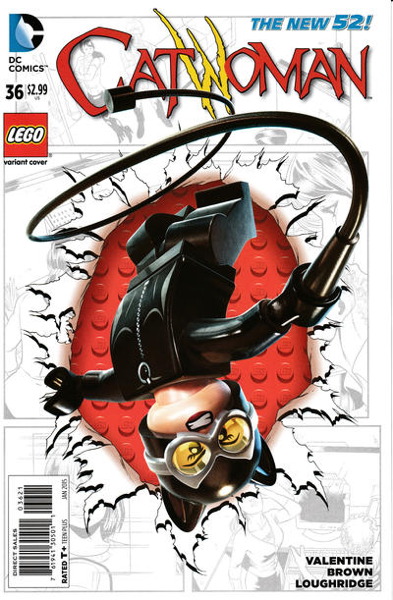
I’ve touched upon this topic before (not long after opening my own store, in fact), where putting a cover on a book that does not reflect the contents is misleading, and frustrating, to potential buyers.
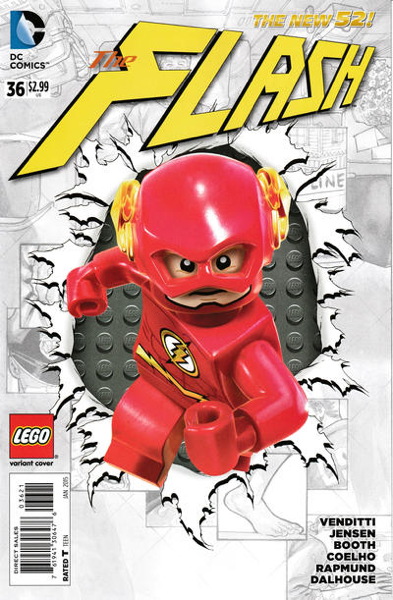
The regular comic fans have mostly caught on to the whole “don’t judge a comic book by its variant cover” thing, but I still get some consumer confusion when it comes to more casual buyers scanning the racks. “Oh look, Deadpool is teaming up with Miles Morales!” “Um, sorry, hate to tell you this….”

Most of the time it feels like it should be fairly apparent that the cover isn’t what’s inside, especially with gag covers like the MAD or Robot Chicken variants. But even those had more than one puzzled person perusing the rack, cracking the covers and wondering why the funny stuff on the outside wasn’t going on in the insides.
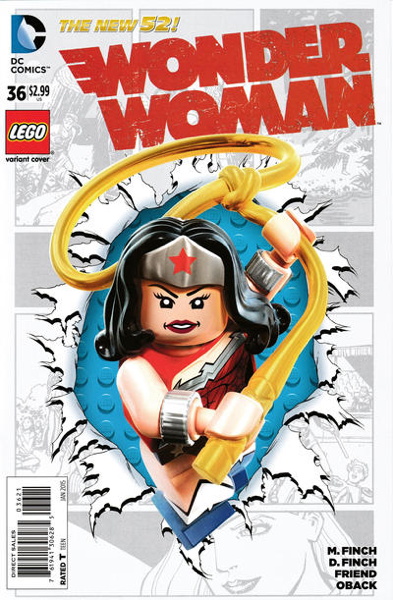
The LEGO covers were particularly egregious in this respect. Created as a crosspromotion with the then-releasing LEGO Batman 3 videogame, each cover featured actual models of playable characters from that game. It was as much a way to get players interested in the game to pick up the comics for the previews. Or, if they’re a big LEGO franchise fan (whether of the games or not), to grab all the covers for their collections.
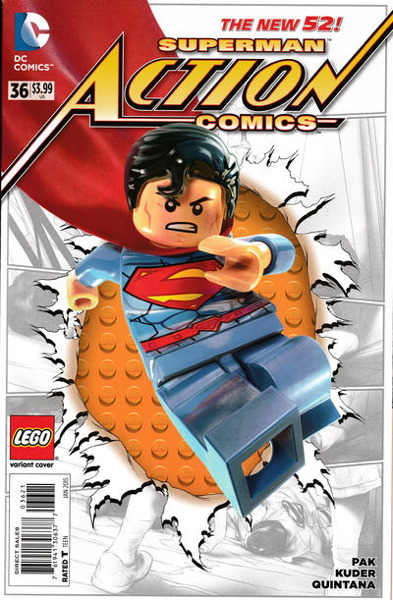
But the ultimate result was lots of kids coming into the shop, seeing the LEGO covers, and grabbing the books thinking they were going to be LEGO-style comics inside. I had a lot of disappointed faces when I told them that wasn’t the case.

To date DC hasn’t released a straight-up DC Super Hero LEGO-style comic book, and neither has Marvel (which has their own extensive LEGO game history). There have certainly been several LEGO superhero squarebound books — activity books, guide books, very young reader books — and some of them even include comics in their content. I’ve had a little success selling some of those, but they’re often accepted as an “okay” second choice, when what the buyer really wanted was a traditional comic book in that style.

Given the seeming popularity of the LEGO super hero videogames and non-comic book published narratives, it seems like maybe actual comic books would be an unnecessary afterthought, a not as lucrative revenue stream as those other ventures. However, it would be nice to have them on the shelves, another vector via which new young readers can try out the medium. Not that the other formats aren’t fine, and it’s good that kids are reading anything, but I am still biased toward the plain ol’ comic book and encourage anything that would get people to continue reading them. Especially kids.
Nicholas inquired
“…Can you shed any light on the mid-90’s Marvel newsstand issues? I’m doing a deep dive on the JRJR run of Spider-Man (which had been renamed to “Peter Parker Spider-Man” at that point) and have come across two versions of many of them (they seem to be during the Clone Saga and the run of issues immediately following the end of that storyline). From what I can see, the newsstand versions were printed on newsprint, and cost $1.50, and the direct market versions were on glossy paper, but priced at $1.95? The weird thing is that at a certain point, it looks like the direct market versions stay at $1.95, and the newsstand versions jump to $1.99 BUT were still printed on newsprint? Then eventually, they all go to $1.99 and are printed on newsprint. I’m very confused, and can kind of remember this happening with some other series (specifically Generation X). It seems ridiculous, and I can’t find anything on the internet about it.”
So here’s what I recall about this particular publishing plan of Marvel’s, mostly in relation to their X-Men line at the time:
In the mid-’90s (in the example, I’m using here, cover date November 1994, so actually probably sometime in September), the adjeectiveless X-Men split into two (well, three) distinct versions. For comic shops, you had your choice of the “Deluxe Edition” on nicer paper, with a convenient “DELUXE” tag on the cover, for $1.95:
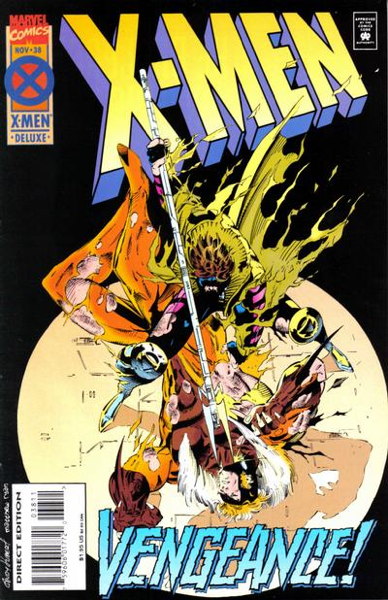
For readers who didn’t want to dish out an extra 45 cents, a $1.50 version printed on not-glossy paper was also offered to the direct market (note: no “DELUXE” tag on the cover):
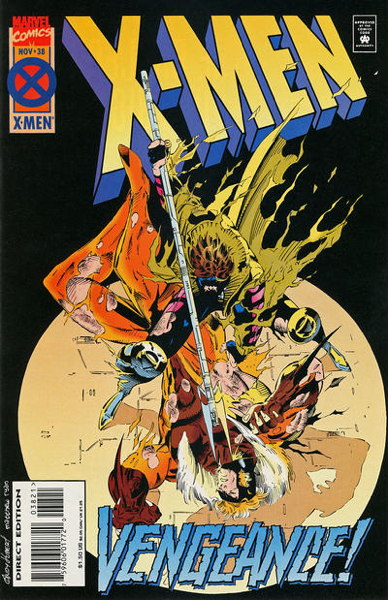
And then for newsstands, the Deluxe Edition was offered, but with a standard UPC code (not sure about the paper stock):
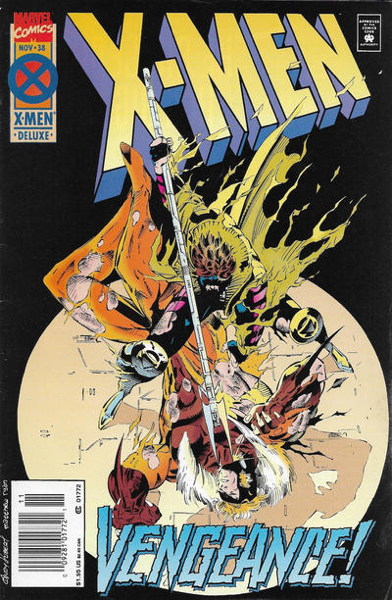
Now here’s where we’re going to depend on my memories of these events, because I’m going to point out something and I don’t have a way of backing it up just yet. However, I recall having written about this in a comic forum I ran on a local BBS at the time, which is why it sticks with me.
My recollection is that Marvel sold this new Deluxe format to fans as a more upscale edition of the comic, for folks who wanted a, I don’t know, classier reading experience or something. If, like I said above, they didn’t want to dole out the extra dosh for smooth silky paper they could rub gently on their skin, fans could buy that $1.50 version, and Marvel would look at sales and see which the fans preferred.
ENTER: MY MEMORY I’M WONDERING ABOUT — the catch was, the $1.50 version would be released a couple of weeks later. I distinctly remember writing at the time on a local BBS “of course the $1.95 version is going to sell better, fans don’t want to wait an extra two weeks when they can get the story now.”
Again, I have no way to back that up. I have no solicitation material from the time (at least, that’s easily accessible), no access to any of my long-ago posts on that BBS…the web archive I once pulled from for this site is gone, and while I backed up a lot of material from the site, I inexplicably didn’t save my own section. Didn’t I know I’d need that for a blog post someday? I’m trying to track it down (I have friends who may still have an archive of all that stuff), and I have a bunch of invoices from the previous place of employment that may shed some light, so if any new information magically appears, I’ll add an update.
EDIT: Folks in the comments section are also recalling this shipping schedule for the Deluxe/Not Deluxe editions.
Anyway,whatever time frame in which those were released, the differently-priced editions seemed to go away after the Age of Apocalypse event (in which all the regular X-books were put on hiatus for a few months and replaced with mini-series all priced at $1.95). Issue #42 of X-Men, just prior to the event, was the last of that series to carry those specific $1.95/$1.50 price points.
Now, Nicholas, you mentioned the weird thing where the direct market edition of some of these titles retained a $1.95 price point, whilst the newsstand editions went up to $1.99. I honestly didn’t remember that, but checking on this X-Men run…yep, sure enough. Starting with issue #57 and running through issue #65 (even including the “-1” special), direct issues were $1.95:
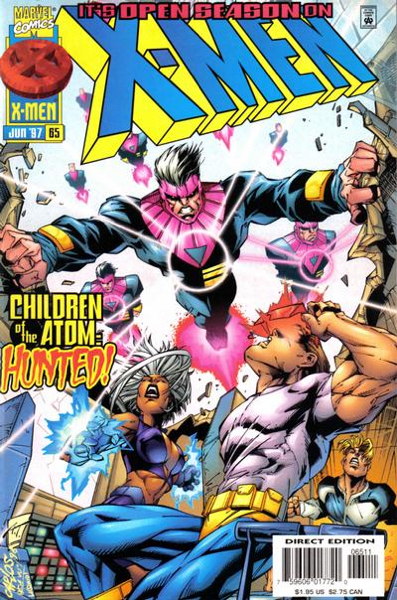
And newsstands were $1.99:
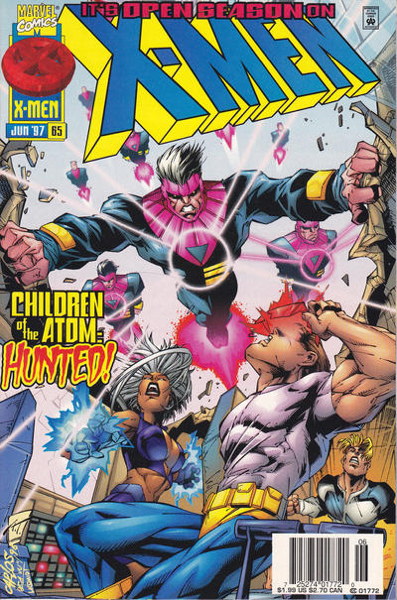
After that everything went up to $1.99 and comic prices never rose ever again.
As to the “why” of all this…well, like I said, initially it was offered as an “option” to fans as to whether or not they wanted to pay more for a fancier product or pay less for something a little more “no frills.” Regardless of the timing of releases of these competing editions, it seemed clearly designed to ease readers into a higher price point, possibly framing it as “it was the readers what wanted the higher cost version!”
Once everything moved to the $1.95/$1.99 price point, I think a possible explanation is this. Comics were at too low a price point for newsstands and bookstores and such to really want to bother with. Raising the price on the newsstand edition (even if only by a few cents) may have been just enough to keep newsstand sellers and distributors from cutting the product line entirely. Perhaps more a psychological move than anything else.
As for being printed on cheaper paper: that’s just Marvel keeping the expenses down. Newsstand distribution numbers weren’t nearly as high as they were in the direct market, and newsstands could return unsold product, so the lower the initial production cost, the more money could potentially be made, or at least the lower the losses would be.
It also could just be the competition versus other comic companies were stronger in the direct market, necessitating a higher quality product, believed unnecessary for the newsstands.
And when it comes to both direct and newsstand editions going to the cheaper paper: just line-wide cost cutting is all. Fancy paper costs too much, so it was either that or raise the price, which, as I said, they would never do ever again.
I don’t know the whole financial end of publisher vis-à-vis distributors, or any of the actual reasons behind some of these decisions, so if anyone wants to clear up the above assumptions, be my guest. But I honestly do believe the initial price differences was sold as a “let the reader decide” thing when, in fact, the decision was already made.
A personal memory from the old shop was when it came to restocking the issues of the various series that had the deluxe/regular price split. I honestly could never remember which comics marked “DELUXE” had an accompanying non-deluxe edition. I’d have to make intricate notes as to which versions I had to go looking for in the back room. Yes, I had to do all this restocking manually, this was before robots took over everything.
Nicholas, I hope this answers your questions, or at least gives you some options to consider in regards to these quarter-century old publishing puzzles. If I get new information, I’ll let you know right here on this very site!
[REMINDER: yesterday was this site’s 18th anniversary post, in which I included an index to all the variant cover-age posts so far]
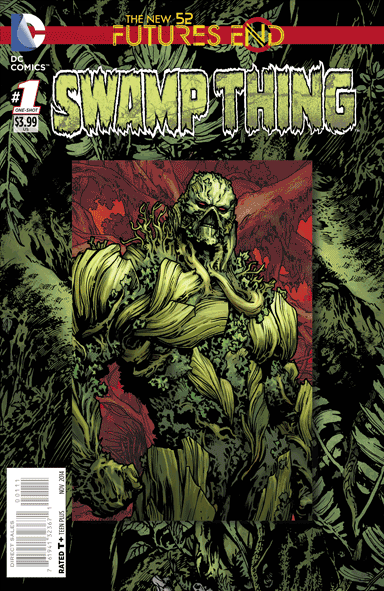
The cover above wasn’t part of DC’s first wave of lenticular covers in 2013, but rather the second in 2014. It does give you an idea of what the lenticular covers looked like (though the second wave looked better than the first). And it wasn’t just lenticular images on these covers (making them strictly a “gimmick” cover and not a variant cover) as regular editions were issued as well with static fronts.
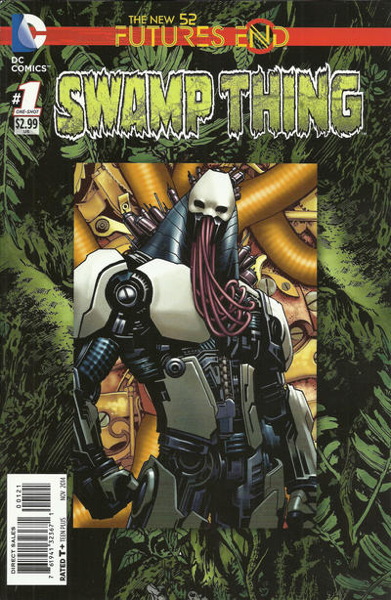
I’ve gone on about DC’s lenticular covers in the past…in real time, in fact, As It Was Happening and YOU Were There! As you may recall, DC announced this great month-long gimmick of producing a bunch of villain-centric one shots for most of their titles, all of which would feature fancy lenticular motion with advanced technology that I seem to remember from children’s books I had in the early ’70s. Long story short, even with extra advanced solicitation times, orders were such that the printers could not produce enough of the covers in time, resulting in allocations.
Interestingly, what I’d forgotten was that there were only lenticular covers initially planned for all these comics. It wasn’t until DC announced “Oops, Not Enough Lenticulars” that the “regular” static-imaged covers were offered to “fill out” any orders on the fancy covers that may have been cut short by the allocations. As I recall, you could just order however many you wanted of those.
Here’s a sample of a lenticular cover from this initial 2013 wave (non-animated, sorry):
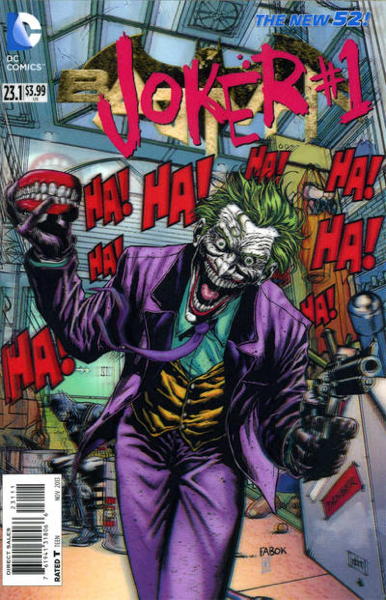
And here’s the standard edition:
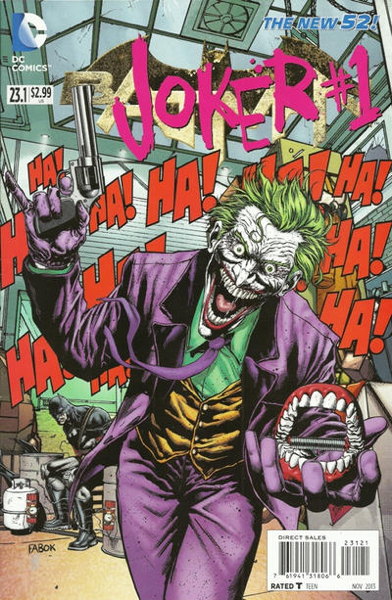
If you want more detail on what was happening at the time, here are my original posts on the matter: 1 2. As I recall, I had enough of the fancy covers to fill pulls, and some people preferred the standard buck-cheaper perhaps-not-as-gimmicky-and-distracting standard ones. I just hoped they wouldn’t pull something like this again.
Then suddenly out of nowhere DC did it again the next year, with the printing kinks worked out, apparently, and with standard cover editions offered from the get-go. You can refer back to my posts on the 2014 wave (1 2) for a more in-depth look, or perhaps “look at it from different angles.” I don’t know, there’s a joke there somewhere. But again, in short…sold fine, no panicked rush on the covers because they were in short supply like that first time.
Now, years later…well, when I ordered those, I was working for my previous place of employment. In fact, that second wave of lenticulars was one of the last Big Things I ordered for that store before opening up my own shop. As such, I don’t have any leftovers from those initial orders in my backstock, and I never ordered them for my own place. I’ve been dependent on acquiring them in collections, and, yes, sure, I have picked up a few over the years.
Oddly enough, I seem to see more from the first “limited in supply” wave than I do from the second “order as many as you want, we’ve got plenty!” wave. My recollection was that both waves sold well…we did have some leftovers on the second wave, but it’s not like we didn’t sell plenty of copies of those, too.
And speaking of the aftermarket…some of those initial lenticular releases, unsurprisingly, got targeted by eBay flippers and were quickly thrown online. In particular, the “Joker’s Daughter” issue (remember her?) of Batman: The Dark Knight (#23.4) was The Hot One, though a quick look at eBay shows you can buy ’em for around $10. That Joker one I pictured above was is another one that acquired a premium price for a bit, though I think that was one of the higher-ordered (and not-as-allocated) issues. On eBay now, about $10 – $15, which is still pretty good.
Most other issues, of both waves, at least in my experience, sell about about $4 to $5. It’s one of those deals, like with many of the ’90s gimmick covers, where people fish ’em out of the back issue bins, say “ooh neat!” and buy it. Not fast sellers, not “in demand” items (no one comes in asking for them) but more often than not they’ll buy ’em when they see ’em.
In 2017, Marvel gave lenticular covers the ol’ college try as part of one of their ongoing series of relaunches of various titles, and, um, well
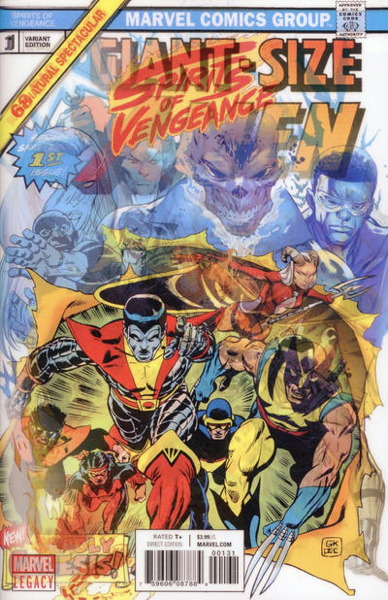
In my opinion they were biting off a little more than they could chew, there, by trying to switch between two entirely different complicated cover images which 1) weren’t kept distinct enough from each other, making a blurry mess, and 2) would confused customers as to what comic they were actually looking at. “Is that…Giant-Size X-Men? What’s going on?”
They weren’t all that bad, but good gravy, they weren’t all that good, either. These I did end up ordering at my own store, and I’m pretty sure I rid myself of any excess in the dollar bins. Ah well. Oh, and keeping with the variant theme…it’s Marvel, of course there were variants. Here’s the main cover:
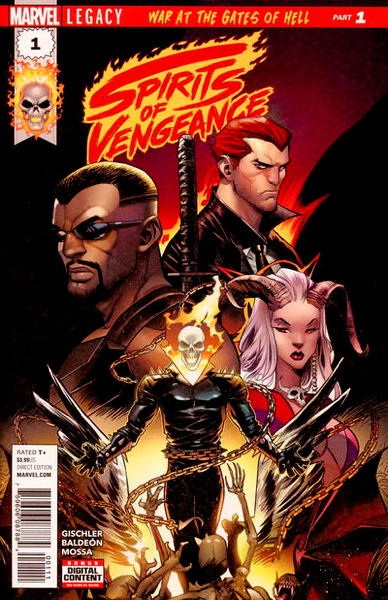
…and if you go to this page, you can see the rest of the variants this issue had. I recommend the “How to Draw Ghost Rider” one, which is pretty good.
The only company regularly flying the lenticular banner nowadays is Absolute Comics, and you can see a sample of one here. Looking back through Diamond Comics’ database, I see other publishers tried out lenticulars in recently years, on such titles as Zombie Tramp and Ninjas and Robots.
But DC and Marvel haven’t repeated the line-wide fancy movin’ cover thing since those initial attempts (though DC did spring for one on Doomsday Clock #1 in the true spirit of Watchmen). I wouldn’t mind seeing more in the future…I like them, they look neat on the rack, and the customers seem to like them too. Just…make sure they work, and maybe don’t unload dozens of them on us simultaneously.
« Older Entries
Newer Entries »



































